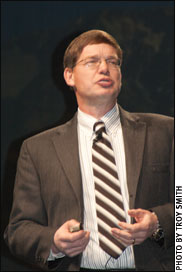Cattle-Fax Forsees Halt
to Cow Herd Contraction
by Troy Smith for Angus Productions Inc.

While cattle feeders kept pulling cattle forward and kept pretty current in 2010, more recent signals are telling them to feed cattle to heavier weights, Kevin Good said.
DENVER (Feb. 4, 2011) — Beef cow numbers have declined during 13 of the past 15 years, and some further liquidation is likely to continue during the coming year. But the end may be in sight, according to Kevin Good, Cattle-Fax market analyst. Speaking during the Cattle-Fax Outlook Seminar in conjunction with the 2011 Cattle Industry Convention in Denver, Good talked about cattle numbers, projected prices, and predicted a halt to contraction of the U.S. cow herd.
Good shared information from Cattle-Fax analyses suggesting the smallest total tally of beef cows since 1963 will shrink by another 250,000 head in 2011. That will put the count at 30.6 million head, but Good looks for liquidation to end and modest expansion to begin, at least by 2013.
“Liquidation is slowing and, over the next 12 to 24 months, I expect it to stop.” predicted Good, saying higher heifer retention should initiate a rebound.
Talking about current cattle supplies, Good said recent feedlot placements were up about 5%, but supplies of feeder cattle and calves are relatively low. He predicts lower placements from March forward. In 2011, total fed-cattle slaughter is expected to be down by 2%.
Good expressed some concern, however. While cattle feeders kept pulling cattle forward and kept pretty current in 2010, more recent signals are telling them to feed cattle to heavier weights.
“This year, higher input costs will challenge profitability of feedlot operators,” said Good. “Packer profits will be squeezed a bit because of lower numbers going through the system.”
Good said he expects greater production during the first half of the year, but less in the second half. He looks for 300,000-500,000 fewer fed cattle to be marketed this year, and fewer non-fed cattle. That will be offset somewhat by heavier finished weights.
“Prices for feds should average $104 to $105 (per hundredweight) for the year — about $10 higher than last year,” added Good. “Five-weight steer calves should average $140, in an extremely explosive market. That makes feedlot breakevens high. Without hedging, cattle feeders could be looking at a negative year. Cow-calf producers will be in the driver’s seat and the vast majority should be profitable.”
###
Editor’s Note: The above article was written under contract or by staff of Angus Productions Inc. (API). It may not be reprinted without express permission of API. To request reprint permision, contact the editor at 816-383-5200.
www.4cattlemen.com is an event coverage site provided by the editorial team at Angus Productions Inc. (API), publisher of the Angus Journal, the Angus Beef Bulletin, the Angus Beef Bulletin EXTRA and the Angus e-List. For questions about this site, to submit an article for our consideration, or to report a broken link, contact the editor at 816-383-5200; 3201 Frederick Ave., Saint Joseph, MO 64506.
API claims copyright to this web site as presented. We welcome educational venues and cattlemen to link to this site as a service to their audience.

